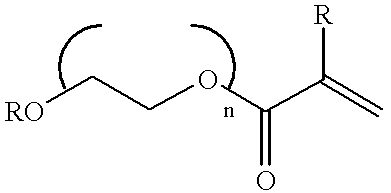Ink jet ink compositions and processes thereof
a technology of ink jet ink and pigment, applied in the direction of inks, coatings, emulsion paints, etc., can solve the problems of pigment dispersions destabilizing, dye-based ink jet inks suffering from deficiencies in waterfastness and lightfastness, and separation from the nozzle of bulging ink
- Summary
- Abstract
- Description
- Claims
- Application Information
AI Technical Summary
Problems solved by technology
Method used
Image
Examples
example ii
Ink Preparation:
5 Grams of the optional additive primarily selected for anticockling of trimethylolpropane were mixed with 21 grams of sulfolane solution at 95 weight percent and to 17.5 weight percent of deionized water. This mixture was stirred on a roll mill for about 7 minutes to enable dissolution of the trimethylolpropane. The above mixture was added dropwise through a separatory funnel into a flask comprising 25 grams of Levanyl A-SF carbon black dispersion containing 28 weight percent of carbon black, 4 weight percent of a dispersant of a naphthalene sulfuric acid condensed formaldehyde, 68 weight percent of water, and 17.5 grams of deionized water. After mixing for approximately 2 minutes, a mixture of 1.79 grams of latex from Example I (the emulsion comprised of 29.7 percent by weight of poly(methyl methylacrylate-butyl methacrylate-acrylic acid) resin, 0.5 percent by weight of sodium dodecylbenzene sulfonate, 0.5 percent by weight Triton X-100 (alkylphenoxypolyethanol), a...
example iii
Resin:
A latex emulsion comprised of 79 weight percent of high, 110.degree. C., Tg monomers of phenyl methacrylate (homopolymer with a Tg of 110.degree. C.) and acrylic acid (homopolymer with a Tg of 106.degree. C.), and 21 weight percent of a low, minus (-) 24.degree. C., Tg monomer of polyethyleneglycol methacrylate (homopolymer with a Tg of -24.degree. C.). A latex resulted that was derived from phenyl methacrylate / polyethyleneglycol methacrylate / acrylic acid terpolymer of 55:21:24 composition. The latex was prepared by a batch emulsion polymerization process. In a 1 liter kettle equipped with a mechanical stirrer was charded with 240 grams of water, 18 grams of sodium dodecyl benzene sulfonate obtained from Rhone-Poulenc as Rhodacal DS-10, and 2 grams of Triton X-100 (alkylphenoxypolyethenol) available from Aldrich Chemicals, and this mixture was stirred for 2 hours at about 100 revolutions per minute. To this solution were then added 1.8 grams of ammonium persulfate followed by ...
example iv
Ink Preparation:
0.05 Gram of polyethyleneoxide (M.sub.w =8,000 grams / mole) (obtained from Polysciences), 31.52 grams of sulfolane solution at 95 weight percent, was added to 38.49 grams of deionized water, and 1 gram of the smearing additive polyether-polymethyl-siloxane copolymer (obtained from Goldschmidt named Tegopren 5884). 6 Grams of 2-pyrrolidinone obtained from Aldrich were then added to the above mixture with 1.94 grams of the latex Example II above (emulsion comprised of 34 weight percent of poly(phenyl methacrylate / polyethyleneglycol methacrylate / acrylic acid) resin, 0.5 weight percent of sodium dodecylbenzene sulfonate, 0.5 percent by weight of Triton X-100 (alkylphenoxypolyethanol), and 65 percent by weight of water). This mixture was stirred on a roll mill for about 10 minutes to enable dissolution of the solids. The above mixture was added dropwise through a separatory funnel to another flask containing 21 grams of Cabot carbon black dispersion (Cabojet 300), containe...
PUM
| Property | Measurement | Unit |
|---|---|---|
| glass transition temperature | aaaaa | aaaaa |
| glass transition temperature | aaaaa | aaaaa |
| glass transition temperature | aaaaa | aaaaa |
Abstract
Description
Claims
Application Information
 Login to View More
Login to View More - R&D
- Intellectual Property
- Life Sciences
- Materials
- Tech Scout
- Unparalleled Data Quality
- Higher Quality Content
- 60% Fewer Hallucinations
Browse by: Latest US Patents, China's latest patents, Technical Efficacy Thesaurus, Application Domain, Technology Topic, Popular Technical Reports.
© 2025 PatSnap. All rights reserved.Legal|Privacy policy|Modern Slavery Act Transparency Statement|Sitemap|About US| Contact US: help@patsnap.com

